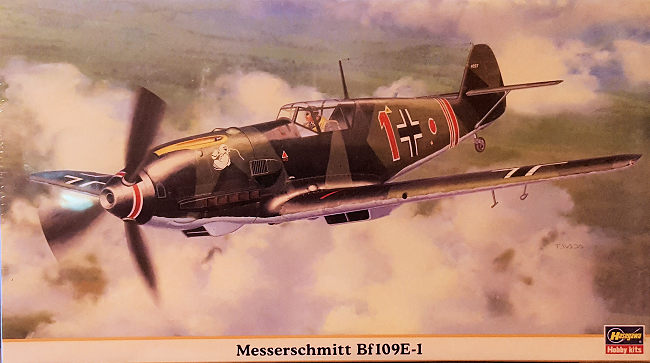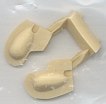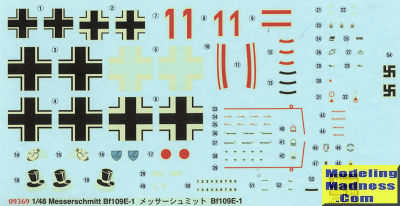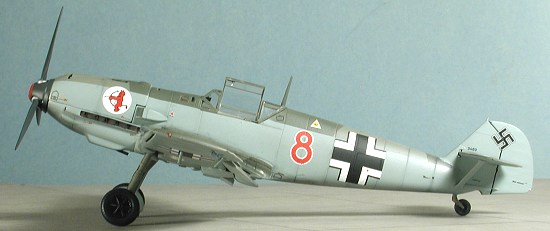
Hasegawa 1/48 Bf-109E-1
|
KIT # |
09369 |
|
PRICE: |
2400 yen SRP |
|
DECALS: |
Two options |
|
REVIEWER: |
Scott Van Aken |
|
NOTES: |
2001 Limited Edition. Includes resin bits to backdate to an E-1 |

|
HISTORY |
It wasn't until the Bf-109E-4 went into production that Messerschmitt settled on cannon armament for the wings. At that time, combat experience had shown that a more robust canopy and armor plating might not be a bad idea and so was made standard. Some of that was retrofitted to the earlier E-1 and E-3 airframes. Several E-1s were also modified for fighter-bomber roles and outfitted with a bomb rack. These early 109Es were NOT plumbed for a drop tank. By the time the F models entered service, most of the early E-1/3 planes had either been sold overseas, sent to training squadrons, or used in areas where there wasn't much Allied air activity.
|
THE KIT |
 The
only thing that is different in this kit from Hasegawa's E-3 offering is the inclusion of a resin plug for the
under wing cannon bulges. You see, since the E-1 didn't have these
bulges, they need to be removed. Howev
The
only thing that is different in this kit from Hasegawa's E-3 offering is the inclusion of a resin plug for the
under wing cannon bulges. You see, since the E-1 didn't have these
bulges, they need to be removed. Howev er, if you just sand them down,
you'll have a huge hole in the lower wing. Hasegawa figures that most
modelers must be too dumb to simply fill the bulges with superglue and
sand this area, so they have included these resin plugs. Of course, you
still have to attach them with superglue and then sand them down smooth,
but at least you don't have to wait for several layers of superglue to
dry.
er, if you just sand them down,
you'll have a huge hole in the lower wing. Hasegawa figures that most
modelers must be too dumb to simply fill the bulges with superglue and
sand this area, so they have included these resin plugs. Of course, you
still have to attach them with superglue and then sand them down smooth,
but at least you don't have to wait for several layers of superglue to
dry.
You also have to cut off the cannon barrels and drill out holes for the wing machine guns. The only thing that Hasegawa did not point out is that when the lower wing bulge is removed, there is a square access plate in its place. Not a very big concern for most of us but those who want everything to be perfect will have to add it.
 The instructions are for the 'Emil 3' boxing. An
addendum sheet basically replaces step 3 where the wings are glued
together. Markings are provided for two aircraft.
Both aircraft are in the RLM 70/71/65 splinter scheme from 1939 so there will
be quite a bit of masking required. The box art plane with the yellow gun
troughs is from 2./JG 77 in September 1939 as flown by Hannes Trautloft. The
other is from 5./JG 77 as flown by Winfried Schmidt and has a yellow
spinner. For those not wanting to use kit decals, there are a
rather large number of aftermarket decals for the E-1 version to choose
from.The kit decals are old school and have off-white white insignia.
The instructions are for the 'Emil 3' boxing. An
addendum sheet basically replaces step 3 where the wings are glued
together. Markings are provided for two aircraft.
Both aircraft are in the RLM 70/71/65 splinter scheme from 1939 so there will
be quite a bit of masking required. The box art plane with the yellow gun
troughs is from 2./JG 77 in September 1939 as flown by Hannes Trautloft. The
other is from 5./JG 77 as flown by Winfried Schmidt and has a yellow
spinner. For those not wanting to use kit decals, there are a
rather large number of aftermarket decals for the E-1 version to choose
from.The kit decals are old school and have off-white white insignia.
|
CONCLUSIONS |
Over the years, the E-1 had not really
been that well covered in this scale. Hobbycraft did one, but it is not the
best 109E in this scale. Later, Airfix produced one when it was doing 109Es and Eduard did one that is fiddly to the max. Recently Wingsy has
 produced
one that, being a new kit, is touted by many as being the one to get.
However, you do pay a price for that new one so
it is up to the builder as to which to seek out. This one is not bad at all,
being fairly easy to build with no real fiddly bits and only the need to
alter the gun bulges that puts it into the somewhat experienced class. I
built one of their other boxings of this variant and have included a photo
for you.
produced
one that, being a new kit, is touted by many as being the one to get.
However, you do pay a price for that new one so
it is up to the builder as to which to seek out. This one is not bad at all,
being fairly easy to build with no real fiddly bits and only the need to
alter the gun bulges that puts it into the somewhat experienced class. I
built one of their other boxings of this variant and have included a photo
for you.
July 2021
Copyright ModelingMadness.com. All rights reserved. No reproduction in part or in whole without express permission.
If you would like your product reviewed fairly and fairly quickly, please contact the editor or see other details in the Note to Contributors.